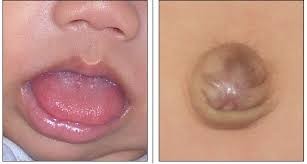Beckwith-Wiedemann syndrome (BWS) is an overgrowth disorder disease present at birth, characterized by an increased risk for childhood cancer. Five typical pathognomonic clinical features are used for diagnosis of this syndrome: macroglossia, macrosomia, midline abdominal wall defects (omphalocele, umbilical hernia, diastasis recti), abnormal ear creases or ear pits, and neonatal hypoglycemia. This syndrome is caused by complex rearrangements at the 11p15 chromosomal region. The region contains genes which are imprinted, meaning that they are expressed differently depending on whether the copies are of maternal or paternal origin and this syndrome is therefore also associated with uniparental disomy (UPD) for chromosome 11.
Beckwith-Wiedemann syndrome

The techniques applied (MLPA and MS-MLPA) enable us to detect genomic deletions/duplications, the methylation status of the 11p15 imprinted regions as well as uniparental disomy (UPD), which together account for >90% of all cases.
This technique is superior to FISH, due to its enhanced analytical sensitivity and reliability.